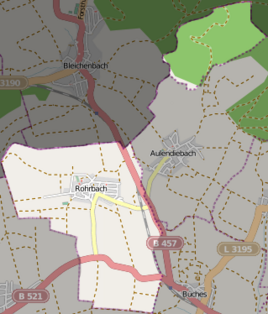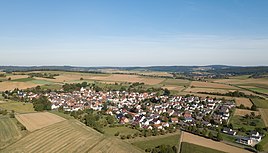Rohrbach (Büdingen)
|
Rohrbach
City of Büdingen
|
|
|---|---|
| Coordinates: 50 ° 18 ′ 36 ″ N , 9 ° 3 ′ 3 ″ E | |
| Height : | 149 m |
| Area : | 4.66 km² |
| Residents : | 828 (Jun. 30, 2019) |
| Population density : | 178 inhabitants / km² |
| Incorporation : | December 31, 1971 |
| Postal code : | 63654 |
| Area code : | 06041 |
|
Overview map of Rohrbach (Büdingen)
|
|
|
View over Rorbach, 2019
|
|
Rohrbach is a district of Büdingen in the Wetterau district . The neighboring districts are Aulendiebach , Düdelsheim and the city Ortenberg related Bleichenbach .
location
Rohrbach is five kilometers northwest of Büdingen.
history
" Rorbah" (Rohrbach) was first mentioned in an undated document between 780 and 817 in the Codex Eberhardi , in which a landlord Udalrich donated goods in Rohrbach to the Fulda monastery . The document comes from the time of Abbots Baugulf and Ratgar .
A document from 1247 certifies the existence of the Reichsburg Glauburg on the Glauberg and the ministerials from Rohrbach, Büches , Düdelsheim and Bleichenbach as the castle men of this castle.
On December 31, 1971, Rohrbach was incorporated into the city of Büdingen as part of the regional reform in Hesse .
Manorial rule
In the Middle Ages, a noble family named itself after Rohrbach . In 1219 a Burgmann Rucker von Rohrbach testified to a donation in the Gründau court.
The von Rohrbach dynasty belonged to the knighthood and was enfeoffed with the rulership of the village, initially by the lords of Büdingen , after their extinction half by the lords of Hohenlohe-Brauneck and the other half by the lords of Ysenburg. They had their own property in the village, which was free and carefree, as well as income from the rugge court and the permanent courtyard, which was transferred to the Lords of Cleen in the 15th century .
After disputes about taxes and authorizations, Johann von Ysenburg ended his feudal relationship with Rucker von Rohrbach and his son Gerlach in 1386. He takes over direct rule over the Ysenburg half of the village.
In 1450, Count Diether von Ysenburg also acquired the Brauneck half of the village of Rohrbach from Siegfried von Rheinberg and his wife Gude for 300 florins. The entire village with all its rights and uses was then owned by the Büdinger Count House.
It is also known that Heinrich Rohrbach was accepted into the noble patrician society of Alten Limpurg in Frankfurt am Main in 1466 . As rich wholesalers, the Rohrbachs lent the imperial city money in times of war, and the population received bread grain from their large granaries. Bernhard Rohrbach, to whom his father had given a handwritten missal, the "Missale Rohrbachense", for his wedding in 1465, and his son Job left an illuminating diary for posterity, which gives an insight into customs and traditions as well as the musical life of the 15th century in Frankfurt . The Rohrbach dynasty in Frankfurt was extinguished around 1570, and today Rohrbachstrasse in the north end of Frankfurt is named after them.
1815 was the Principality of Isenburg by the Congress of Vienna mediated . As a result, Rohrbach and the former county of Isenburg-Büdingen fell to the Grand Duchy of Hesse (Hessen-Darmstadt) in 1816 .
Ortenberg Court
Rohrbach belonged to the Glauberg / Ortenberg court , which together with the Staden court formed the old Ortenberg lordship. The Lords of Ortenberg belonged to the family of the Lords of Büdingen, which died out before 1247. Until 1601, the Ortenberg court was ruled in varying proportions by different noble families. Among other things, parts of the court belonged to the territory of the Breuberg, Trimberg, Hohenlohe-Brauneck, Ysenburg and Nassau families.
In 1601 the Ortenberg court was divided, while Rohrbach, Düdelsheim with Oberdorf, Stockheim and Leustadt as well as parts of Effolderbach , Calbach, Orleshausen and Aulendiebach were assigned to the Counts of Ysenburg-Büdingen.
church
The Braunecker part of Rohrbach also included the patronage of the St. Nicholas Church in Rohrbach, which was acquired by the Ysenburg family in 1450 together with the manor and which the Prince of Ysenburg-Büdingen is still entitled to today. At that time, dependent chapels were the St. Peters chapel in Stockheim and the Nothelfer chapel in Aulendiebach. In 1820 the St. Nicholas Church was demolished to make way for today's church building. In a report by the Büdinger consortium of February 18, 1818, which preceded the new building, its condition is described as follows: "The church in question, the construction of which dates back to the grayest antiquity, [looks] more like a barn than a house of God. [The] Enclosing walls, which were built up with lime on the inside and outside, but in between with loose and unrelated stones, [are] significantly damaged in several places " 1956 wrote Pastor Türk on the anniversary of the choral society that the gravestones of the clergy buried in the old church were used as steps for the long staircase of the new building.
The Rohrbacher church has an organ built by Johann-Conrad Bürgy in 1789, which was already present in the old St. Nikolaus church. After several restorations, the organ is still partially there.
Jewish community
Rohrbach had a fairly large Jewish community (in 1910 15% of all residents belonged to the Jewish community). The dead of the Jewish community were buried in the cemetery in Düdelsheim until 1878. In 1878 the Jewish community in Rohrbach acquired a piece of land to set up its own cemetery. This cemetery was used from 1880. The area is 2.57 acres.
In the course of the pogroms in 1939, all Jewish residents were expelled from Rohrbach. The former synagogue housed the village school for some time.
school
In 1581, at the suggestion of the Rohrbach parish, the son of the late pastor Georg Kuhn was employed as a bell ringer and teacher. Since then there has been a school in Rohrbach. The Rohrbach school was also attended by the children from Aulendiebach (until 1750) and Büches (until 1795).
In 1910 Rohrbach and his school are described as follows:
“Rohrbach, 347 ev., 60 Israeli inhabitants, in a hilly area, 3 km from the forest, 5 km from Büdingen (grammar school, high school for children, pharmacy), from station Bleichenbach (Gießen - Gelnhausen) 2 km, from station Büches 3 km , matching trains; from Post Agency Düdelsheim (doctor) 3 km, 9 ½ in the morning post car to Rohrbach; in Rohrbach ev. parish, agriculture, cattle breeding, trade, some quite wealthy farmers, mostly middle class; 127 hectares of community property, community levy 81 percent. "
"School: One-class - 61 students, 2 hours of manual labor 35 marks each. The school hall built in 1878, quite bright and large; no basement, in a quiet location. - Further education school, one class of 12 students, 4 hours from 2 a.m. to 4 a.m., a total of 90 marks. Presentation: Prince of Ysenburg-Büdingen in Büdingen. School-free: Parish fair on Monday, 2 days in the Ortenberg market and 1 hail day on the Wednesday after Whitsun (church service). "
The last teacher at the Rohrbacher Schule was Fritz Dönges, who taught until 1969. Since then, children from Rohrbach have attended primary and secondary schools in Düdelsheim as well as secondary schools in Büdingen , Altenstadt and Konradsdorf .
Population development
|
coat of arms
Blazon : "In silver a rising black tip."
The coat of arms was adopted on May 19, 2017 by the city council of Büdingen according to § 14 Hessische Gemeindeordnung (HGO) as the coat of arms of the Rohrbach district.
societies
In Rohrbach there is the possibility to become a member of various sports and cultural associations. The soccer club RSV 1962 Rohrbach eV and the gymnastics group Rohrbach are ideal for sports clubs. In the cultural area there is the men's choir Eintracht Rohrbach and the theater group "Rohrbacher-Klappe". There is also the small animal breeding association H 128 Rohrbach and the nature and bird protection group Rohrbach eV Fire protection in the village is ensured by the Rohrbach volunteer fire brigade with its own youth fire brigade.
traffic
Rohrbach is 6 km from the A 45 motorway ( Altenstadt junction ). Buses in the direction of Büdingen, Altenstadt and Stockheim run several times a day.
Regular events
A foreign meeting of the volunteer fire brigade with the participation of the other associations takes place during the carnival season as well as the tool shed festival on Corpus Christi, there are also regular events on Father's Day barbecues by the men's choir, church festival and lantern parade on St.
Theatrical performances of the Rohrbach theater group take place several times a year.
On the third weekend in November the rabbit show of the small animal breeding association H 128 Rohrbach takes place. As well as the table evaluation of the small animal breeders on October 3rd every year.
Rohrbach's sons and daughters
- Wilhelm Bähr (1863–1938), Hessian politician (anti-Semite, HBB) and former member of the 2nd Chamber of the Estates of the Grand Duchy of Hesse
- Otto Jakobi (born December 26, 1908 in Rohrbach, † September 16, 1964 in Rodheim vdH), pastor in Eisemroth / Dillkreis, 1936–1949, Büdingen, 1949–1958 and Rodheim vdH (1958–1964)
literature
- Hans Georg Ruppel (edit.): Historical place directory for the area of the former Grand Duchy and People's State of Hesse with evidence of district and court affiliation from 1820 until the changes in the course of the municipal territorial reform . = Darmstädter Archivschriften 2. 1976, p. 181.
- Architectural monuments in Hessen. Monument topography Wetteraukreis I , Braunschweig / Wiesbaden, Friedr. Vieweg & Sohn 1982, ISBN 3-528-06231-2 , pp. 176-178
Individual evidence
- ↑ Statistics on the website of the city of Büdingen (PDF; 21.5 kB), accessed in January 2016.
- ↑ Population figures on the city of Büdingen's website , accessed in June 2016.
- ↑ Eltigunt tradidit sancto Bonifacio bona sua in Rorbah et in Ansensheim, quidquid proprietatis habuit. (Heinrich Meyer zu Ermgassen (Ed.): The Codex Eberhardi of the Fulda Monastery. 3 vol. Marburg 1995–2007), here vol. II, p. 208 (111 rb ).
- ↑ Udalrih de Rorbah tradidit sancto Bonifacio, quicquid proprietatis habuit in Wetereiba et Graf-felde. (Heinrich Meyer zu Ermgassen (Ed.): The Codex Eberhardi of the Fulda Monastery. 3 vol. Marburg 1995-2007), here vol. II, p. 221 (115 ra ).
- ^ Federal Statistical Office (ed.): Historical municipality directory for the Federal Republic of Germany. Name, border and key number changes in municipalities, counties and administrative districts from May 27, 1970 to December 31, 1982 . W. Kohlhammer GmbH, Stuttgart and Mainz 1983, ISBN 3-17-003263-1 , p. 353 .
- ^ Boundary change and integration agreement of November 26, 1971
- ^ Roth, Emil: Hessische Schulstatistik, an information book about the local and school conditions of all communities in the Grand Duchy of Hesse , p. 190
Web links
- The place on the website of the city of Büdingen
- "Rohrbach, Wetteraukreis". Historical local dictionary for Hessen. In: Landesgeschichtliches Informationssystem Hessen (LAGIS).



